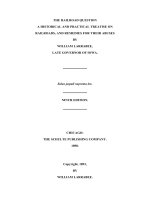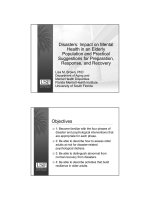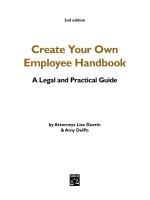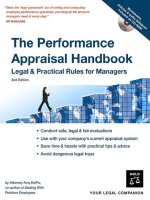the performance appraisal handbook, legal and practical rules for managers 2nd (2007)
Bạn đang xem bản rút gọn của tài liệu. Xem và tải ngay bản đầy đủ của tài liệu tại đây (1.14 MB, 224 trang )
Nolo’s Legal Updater
We’ll send you an email whenever a new edition of this book is
published! Sign up at
www.nolo.com/legalupdater.
Updates @ Nolo.com
Check www.nolo.com/update to nd recent changes
in the law that affect the current edition of your book.
Nolo Customer Service
To make sure that this edition of the book is the most
recent one, call us at 800-728-3555 and ask one of
our friendly customer service representatives.
Or nd out at
www.nolo.com.
The law changes, but Nolo is on top of it! We offer several
ways to make sure you and your Nolo products are up to date:
always up to date
2
1
3
We believe accurate, plain-English legal information should help
you solve many of your own legal problems. But this text is not a
substitute for personalized advice from a knowledgeable lawyer.
If you want the help of a trained professional—and we’ll always
point out situations in which we think that’s a good idea—consult
an attorney licensed to practice in your state.
please note
2nd edition
The Performance
Appraisal Handbook
Legal & Practical Rules for Managers
by Amy DelPo
SECOND EDITION MARCH 2007
Editor
LISA GUERIN
Cover Design SUSAN PUTNEY
Book Design TERRI HEARSH
Production
MARGARET LIVINGSTON
Index JEAN MANN
Proofreading JOE SADUSKY
Printing CONSOLIDATED PRINTERS, INC
DelPo, Amy, 1967-
The performance appraisal handbook : legal & practical rules for managers/
by Amy DelPo 2nd ed.
p. cm.
Contents: An overview of performance appraisal Legal traps Performance
objectives Observation and documentation The interim meeting The year-end
performance appraisal Progressive discipline.
ISBN-13: 978-1-4133-0567-8
ISBN-10: 1-4133-0567-8
1. Employees Rating of United States. 2. Employees Rating of Law and
legislation United States Popular works. I. Title.
HF5549.5.R3D44 2007
658.3'125 dc22
2006047150
Copyright © 2005 and 2007 by Nolo.
ALL RIGHTS RESERVED. PRINTED IN THE USA.
No part of this publication may be reproduced, stored in a retrieval system, or
transmitted in any form or by any means, electronic, mechanical, photocopying,
recording, or otherwise without prior written permission. Reproduction prohi-
bitions do not apply to the forms contained in this product when reproduced
for personal use.
Quantity sales: For information on bulk purchases or corporate premium
sales, please contact the Special Sales Department. For academic sales or
textbook adoptions, ask for Academic Sales. Call 800-955-4775 or write to
Nolo, 950 Parker Street, Berkeley, CA 94710.
Acknowledgments
I would like to thank the following people who helped make this book possible:
My wonderful editor on the first edition of this book, Stephanie Bornstein,
whose legal experience, hard work, and attention to detail made the finished book
worlds better than the draft I handed her at the beginning of the process. More im-
portant, her sense of humor and constant support kept me sane.
Thanks also to my editor on the second edition, Lisa Guerin, for being her usu-
al efficient, professional, and easy-going self. I’ve been writing and editing books
with Lisa since 2001, and it’s always a pleasure.
MindSolve’s Dan Boccabella and Jeff Lyons, who came to Nolo and me search-
ing for a way to serve their customers even better. Their desire to provide the best
and most complete information to MindSolve users was the inspiration for this
book, and their input has helped make it an invaluable tool for frontline managers
everywhere.
Nolo’s Sigrid Metson, whose enthusiasm for this project never waned, even
when mine did. Without her vision and business savvy, this book never would
have seen the light of day. Anyone with so much energy and so many ideas is
surely a national treasure.
The members of the advisory board: Harold Fethe, Ellen Lopresti, Greg Lynn,
Jeff Lyons, Margie Mader-Clark, and Sigrid Metson. I cannot thank them enough
for their insightful comments and valuable suggestions on the first edition of this
book. They generously gave me the benefit of their human resources and manage-
ment experience to make a strong book even stronger. They are leaders in their
fields, and I am honored to have gotten the chance to work with them.
To Margie Mader-Clark, a crackerjack human resources expert, a grateful thanks
for adding her voice, and thoughts, to the CD-ROM at the back of this book. And
speaking of the CD, thanks to Rich Stim for his expertise and skill in putting it all
together for me.
Researcher Stan Jacobson, who haunted countless libraries searching out every
book and article that I requested—and who did it all with a smile.
Proofreader Susan Carlson Greene, whose careful eyes kept many errors out of
the finished product.
Susan Putney for a wonderful cover design. She had the unenviable task of
taking my vague ideas and turning them into something real—and terrific.
Terri Hearsh for designing the book.
And—finally—I’d like to dedicate this book to my son, Charlie, who was born
just before I started work on this project. His smile lights up the world.
About the Author
Attorney Amy DelPo brings more than six years of criminal and civil litigation
experience to her work at Nolo, having litigated cases in all levels of state and
federal courts, including the California Supreme Court and the U.S. Supreme Court.
Before joining Nolo’s staff in January 2000, DelPo specialized in employment
law, handling a wide variety of disputes between employers and employees,
including sexual harassment, discrimination, and wage-and-hour issues. DelPo has
written and edited numerous employoment law titles for Nolo, including Dealing
With Problem Employees (coauthor) and Create Your Own Employee Handbook
(coauthor). DelPo received her law degree with honors from the University of
North Carolina at Chapel Hill. She lives in Denver, Colorado, with her husband
and two children.
About the Advisory Board
Harold Fethe
Harold Fethe served as Senior Vice President at ALZA Corporation, a leading pro-
vider of drug delivery technologies, located in Silicon Valley. In his 30 years at
ALZA, Mr. Fethe managed more than 20 annual performance appraisal cycles that
produced more than 30,000 individual reviews. During this time, the company’s
employment counsel rated the company “best managed” among its many Bay
Area clients. Mr. Fethe also helped develop and patent an online user interface
for performance feedback, which formed the basis for MindSolve Technologies,
an entrepreneurial performance management company now in its eighth year of
double-digit growth.
Ellen Lopresti
Ellen Lopresti is the director of executive performance management for Capgemini
(formerly Ernst & Young), one of the world’s leading providers of consulting,
technology, and outsourcing services. In her 12 years with the company, she has
been the driving force behind the design and implementation of highly effective
performance management processes affecting thousands of employees, with a fo-
cus on identifying and developing high-potential leaders. Ms. Lopresti also worked
as a human resources consultant for both the U.S. Department of Health and
Human Services and the Hay Group. She holds a master’s degree in industrial/
organizational psychology from the University of Baltimore and a bachelor’s
degree in psychology and business from Ithaca College.
Greg Lynn
Greg Lynn serves as the manager of performance management for JEA in
Jacksonville, Florida, one of the largest municipal utilities in the United States.
In his 25 years with JEA, Mr. Lynn has held a variety of strategic positions, includ-
ing director of employee and organizational development, director of training and
safety, and manager of quality control. He has worked to develop systems to
empower employees and measure performance feedback and reward structures.
Mr. Lynn holds a bachelor’s degree in industrial management from the Georgia
Institute of Technology.
Jeff Lyons
Jeff Lyons in one of the founding principals of MindSolve Technologies and
codesigner of MindSolve’s industry-leading software suite, MindSolve Visual
Performance™ (MVP). Mr. Lyons serves as the company’s Chief Client Officer
(CCO)—the “buck-stops-here” point person for MindSolve’s customers and a
key facilitator and adviser from the earliest stages of client relationships. In his
10 years of experience with enterprise-level performance systems, Mr. Lyons has
consulted in the design, implementation, and administration of online performance
assessment and development processes for a diverse, worldwide client base,
including Pfizer, Schroder Investment Management, Sonoco Products, and
Capgemini.
Margie Mader-Clark
Margie Mader-Clark has spent more than 16 years in the field of human resources,
during which she has held executive and senior management positions in
numerous national and global enterprises, including Vontu, Hyperion Solutions,
myplay (BMG Records), America OnLine, Netscape Communications, DataFlex,
and Network Equipment Technologies. Ms. Mader-Clark has served as a consultant
for start-up and midsized companies, specializing in organizational effectiveness,
change initiatives, and leadership coaching. She is the author of Nolo’s The Job
Description Handbook. In addition, she serves on the board of the international
charity Gifts-in-Kind, Inc.
Sigrid Metson
Sigrid Metson has held senior management positions at leading publishers
including Nolo, West, Bancroft-Whitney (the Thomson Corporation), CareThere,
and Reference Software. With expertise in building high-performance teams
and process reengineering, she has introduced more than 30 information-based
products to market. Ms. Metson also played leadership roles in the acquisitions
and integrations of Legal Solutions, The Rutter Group, Barclay’s, and West
Publishing. In addition, she has edited several titles herself, including Secrets of
Successful Writing (RSI).
Craig Vick
Craig Vick has worked in the field of human resources for 14 years, during which
he held executive positions at Owens and Minor Medical, Inc. and Chowan
College, where he also served as adjunct faculty. Mr. Vick’s expertise includes
training and employee development, preventive labor relations, strategic planning,
and performance management. He has also served on the boards of the Urban
League of Greater Richmond and the National Industry Liaison Group, and
currently serves as the board chairperson of the Richmond Industry Liaison Group.
Mr. Vick holds both a master’s degree in education and a bachelor’s degree in
business administration from East Carolina University.
Table of Contents
Introduction
The Value of Performance Evaluations 2
The Value of Legal Knowledge 3
Who Wrote This Book 3
Who Should Read This Book 4
How to Use This Book 4
Icons Used in This Book 5
1
An Overview of Performance Appraisal
The Benefits of a Performance Evaluation System 11
The Elements of an Effective System 13
Your Role 17
Model Appraisal System 18
2
Legal Traps
Don’t Destroy the At-Will Relationship 26
Don’t Undermine Potential Terminations 28
Don’t Harass or Discriminate 31
Don’t Retaliate 37
Don’t Forget to Document 37
3
Performance Objectives
Identifying Job Requirements 46
Identifying Goals 51
When to Set Performance Objectives 60
Writing Requirements and Goals 60
4
Observation and Documentation
Observing Your Employees 68
Maintaining a Performance Log 69
Documenting Ongoing Feedback 75
5
The Interim Meeting
Scheduling the Meeting 87
Preparing for the Meeting 88
Conducting the Meeting 89
After the Meeting 90
6
The Year-End Performance Appraisal
Writing the Evaluation 96
Presenting the Written Evaluation to the Employee 114
Planning the Appraisal Meeting 114
Conducting the Appraisal Meeting 116
Reassessing Job Requirements and Setting Goals 122
Appendixes
A
How to Use the Forms CD-ROM
Installing the Form Files Onto Your Computer 133
Using the Word Processing Files to Create Documents 134
Using PDF Files to Print Out Forms 136
Listening to the Audio Files 138
List of Files Included on the Forms CD-ROM 140
B
Tear-Out Checklists and Forms
Checklists:
Avoiding Legal Trouble
Identifying Job Requirements
Preparing an Employee for Goal Setting
Identifying Goals
Writing Performance Objectives
Documenting Performance
Information to Gather for a Performance Appraisal
Assessing Performance
Common Performance Appraisal Errors
Agenda for the Year-End Appraisal Meeting
Forms:
Performance Log
Kudos to You
Tickler for You
Performance Evaluation
C
State and Federal Laws Prohibiting Discrimination
Federal Fair Employment Laws 178
State Laws Prohibiting Discrimination in Employment 183
Index
Introduction
The Value of Performance Evaluations 2
The Value of Legal Knowledge 3
Who Wrote This Book 3
Who Should Read This Book 4
How to Use This Book 4
Icons Used in This Book 5
2 THE PERFORMANCE APPRAISAL HANDBOOK
I
f you are like most managers, conducting performance evaluations is a regular
part of your job. All too often, however, managers are told to do performance
evaluations without receiving guidance on how to do them well. This book
fills that void, providing you with the information and tools you need to make your
company’s performance appraisal process worthwhile, effective, and even pleasant
for your staff and you. This book also does something that is all too rare in a how-to
book for managers: It educates you about employment law so that you can avoid legal
trouble for your company and yourself while using your legal knowledge to manage
your workforce more effectively.
This book provides you with the most cutting edge techniques for conducting
effective performance reviews. Using the guidelines presented here will ensure that
you continuously improve the performance of your staff and your department each
and every day. Indeed, there’s no better way to keep your team performing at its
peak—and to keep your company at the top of its game.
The Value of Performance Evaluations
If you’ve been told to conduct performance evaluations, it’s because the people
who run your company realize that a performance evaluation system can deliver
important benefits and improve the success of each employee, each department,
and, ultimately, your entire company. And, it’s no wonder why. If done properly,
performance appraisals can:
• motivate employees to perform better and produce more
• help you identify development and training needs
• help employees understand how they can develop and grow
• increase employee morale
• improve the respect employees have for their managers and senior
management
• foster good communication between your staff and you
• identify poor performers and help them get on track, and
• lay the groundwork to fire poor performers lawfully and fairly if they don’t
improve.
INTRODUCTION 3
The Value of Legal Knowledge
As you may have been told, conducting a shoddy performance appraisal can get
your company—and you—into legal trouble. There’s no point in sugarcoating it for
you: Writing the wrong things on a performance appraisal or doing the appraisal
unfairly or improperly can have devastating consequences if you are sued by an
employee. Avoidable mistakes can cost your company a lot of money and cost you
a lot of time and sleep—and even your job or reputation.
It behooves you, then, to gain a basic understanding of the legal principles that
apply to performance appraisals so that you can avoid such mistakes. This book
presents, in plain English, everything you need to know about the law as it applies
to performance appraisals. Armed with this knowledge, you can conduct effective
performance evaluations with confidence that you are on safe legal ground.
Who Wrote This Book
The people who created this book are not academics—they are employment
lawyers, frontline managers, and human resource professionals. They know about
performance appraisals from years of real-world experience. They bring a variety
of perspectives to the information presented here.
Author Amy DelPo is an attorney who has represented employees in lawsuits
against their employers and managers. In case after case, the performance
evaluations played a pivotal role, either inoculating the company from liability
because the manager did such an effective and fair job—or blowing the case wide
open because the manager did something wrong. In addition to this experience,
DelPo has spent countless hours speaking with employees, managers, and
business owners and educating herself about the latest research on performance
appraisal. She has written five books and numerous articles in the fields of
employment law and human resources. In this, her latest book, DelPo applies her
expert knowledge of performance appraisal systems to guide managers through
what works, what doesn’t, and what will either help or hurt if an employee
decides to sue.
This book was reviewed by an advisory board made up of human resources
professionals and managers who have designed and implemented performance
evaluation systems in companies of all types and sizes. The advisory board
members have learned through trial and error how to run appraisal systems
that are as effective as they are legally sound. The board contributed valuable
suggestions to the content of this book.
4 THE PERFORMANCE APPRAISAL HANDBOOK
Who Should Read This Book
This book is for anyone who evaluates employee performance: managers,
supervisors, executives, and human resources professionals. It tells you how to
conduct performance appraisals that are effective and legally sound, within your
company’s existing systems.
This book is for people who work in private workplaces. Employment law
operates slightly differently in government workplaces, and those differences are
beyond the scope of this book.
If the employees of your company belong to one or more unions, much in this
book will be useful to you. Be aware, however, that any collective bargaining
agreement between a union and your company may change some of the
legal rights and obligations described here and may require your performance
evaluation system to differ from the one presented in this book. Do not rely on
this book to interpret your collective bargaining agreement.
How to Use This Book
Think of this book as a companion to your company’s performance appraisal
system. Here you have the practical and legal guidance you need to work within
your system and the law.
If this book ever conflicts with your system, you should follow your system and
consult your human resources manager.
In each chapter, you will find several checklists to help you remember the
important practical and legal principles involved in the task at hand. You can
find tear-out versions of all the checklists and forms in Appendix B and on the
CD-ROM at the back of the book. The CD also includes an interview with the
author and a special bonus interview with Margie Mader-Clark, author of The Job
Description Handbook, on using job descriptions as a performance management
tool.
This book uses a model performance evaluation system, complete with forms
and samples. If your company does not have a system in place, then you are free
to use the forms we provide. If your company does have a system, however, you
should use your company’s forms.
INTRODUCTION 5
Icons Used in This Book
This icon alerts you to a practical tip or good idea.
This icon is a caution to consider potential problems you may encounter.
If you see this icon, there’s a form in Appendix B (and on the CD-ROM at
the back of the book) that will help you with the task at hand.
This icon refers you to related information outside of this book—in other
Nolo books or additional resources.
n
Chapter 1
An Overview of Performance Appraisal
The Benefits of a Performance Evaluation System 11
The Elements of an Effective System 13
A Fair and Communicative Environment 13
Respect for the Employee 13
Focus on the Future 15
Employee Participation 15
Ongoing Feedback 16
Document, Document, Document 16
Your Role 17
Model Appraisal System 18
8 THE PERFORMANCE APPRAISAL HANDBOOK
Chapter Highlights
• Performance appraisal is a process, not a form. It structures your relation-
ship with employees while providing legal protection for your company.
• A good appraisal system includes observation, documentation, and
communication.
• A performance evaluation system can provide many benefits: It can
improve employee performance and morale, identify poor performers
and ways they can improve, and lay the groundwork for legally defensible
discipline and termination.
• A manager’s attitude helps determine whether a performance appraisal
system will succeed. If the manager is enthusiastic about the chance
to work with employees to improve their performance and their work
experiences, the employees will share that enthusiasm.
• A good evaluation system includes support, motivation, communication,
collaboration, fair treatment, documentation, formality, and accountability
and is consistent with the company’s core values and purpose.
• Managers should use evaluation systems to improve future performance,
not punish employees for poor past performance.
• Employees must participate in every aspect of the evaluation process.
Managers can increase employees’ job satisfaction and engender their
trust in the process by bringing them into the loop and giving them power
and responsibility for directing and assessing their own performance.
• Managers must give feedback on an ongoing basis, not just at the year-
end meeting. Managers must document employee performance as it
occurs throughout the year.
• Although communicating negative information is difficult, not communi
-
cating it can be much worse.
CHAPTER 1: AN OVERVIEW OF PERFORMANCE APPRAISAL 9
I
t’s a common misconception that performance appraisal entails simply filling out
an evaluation form—answering prefabricated questions and checking boxes. If
this were the case, you wouldn’t need an entire book to help you do it right, and
your evaluation wouldn’t be worth the paper you wrote it on.
When done correctly, performance appraisal is a process, not a document—it is a
way of structuring your relationship with your employees. A good appraisal system
includes observation, documentation, and communication. It envisions a workplace
in which supervisors know what is happening in their departments (who is doing
what and how well) and document employee performance as it occurs. Supervisors
and their employees should have open lines of communication. Employees should
know how they are doing so they can make adjustments when they veer off
track. Supervisors should know what obstacles get in the way of their employees’
performance so they can remove those obstacles as they arise.
Performance evaluations provide valuable continuity in a world where employees
can change departments and managers during the course of a year. Often, a manager
doesn’t have the benefit of having observed an employee for the entire appraisal
period. If every manager documents employee performance on an ongoing basis, the
new manager can more easily pick up where the old manager left off.
Proper performance evaluations also provide important legal protection for
your company and you. Sooner or later, despite your best efforts, you are bound to
have difficulties with an employee. When this happens, an effective, legally sound
performance evaluation system can serve as your first line of defense. Not only will
it help you identify and deal with most employee problems before they rage out
of control, it will also lay the groundwork for discipline and, if necessary, legally
defensible termination when problems cannot be resolved.
Most lawsuits arise from the emotional state of the employee. Employees who feel
treated unfairly or who are surprised by an unfavorable management decision are
more likely to complain and to sue. Performance evaluations make the workplace
more fair and predictable, thereby reducing the chances of disgruntled—and,
therefore, litigious—employees.
This chapter provides an overview of performance evaluation systems by exploring
their benefits, considering the qualities shared by effective systems, and introducing
you to the steps in the model system this book presents.









